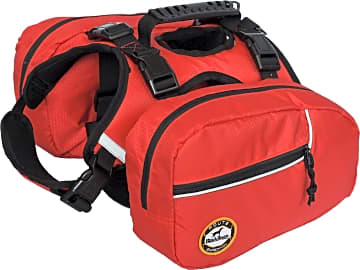The 10 Best Dog Backpacks

This wiki has been updated 41 times since it was first published in April of 2015. When you go on hikes and camping trips, you have a lot of gear to lug, so it makes sense for any canine companions to carry their fair share. These dog backpacks are equipped with pouches for holding things like water bowls, toys, and kibble, and each pack is designed with a pup's comfort in mind. All are built to hold up to plenty of outdoor adventures. When users buy our independently chosen editorial picks, we may earn commissions to help fund the Wiki.
Editor's Notes
February 04, 2020:
We wanted to create a list of dog packs that could stand the test of time, no matter how active your pup is, and would make some of the obvious struggles of hiking with a canine a bit easier to manage. On that note, we eliminated the Frontpet Explorer since it was limited in storage space, and we much prefer options that can hold lots of stuff, like the Smartelf 2-In-1 Camping, which can easily contain a few days worth of food, and the OneTigris Rucksack, which not only has plenty of pockets but also has a lot of attachment loops and bungee cords.
Of course, a pup's comfort is important too, so we like how well the Crest Stone 2207 balances weight, but we got rid of the Ruff Armour Rucksack, because it didn't distribute loads evenly. The Doggles Extreme BPEXLG-09 is another top pick for comfort because of its ergonomic design.
Safety is a priority as well, which is why we had to get rid of the RC Canine Ultimate, as its leash attachment proved to be flimsy. The Go Fresh Pet 2-in-1 and the Smartelf 2-In-1 Camping both have reflective trim to improve night time safety. Combine these with a clip-on flashlight and you have the perfect combination for night owl pet owners.
Special Honors
Supreme Dog Garage Furdi Monster Eyes Backpack Harness This backpack looks just like a human accessory and is ideal for storing small items like treats and toys. Made of abrasion-resistant nylon, it should hold up to plenty of use. It has two zippered pockets — one of which is on the exterior for quick access to belongings — comes in two sizes, and has a metal ring for secure leash attachment. supremedoggarage.com
Companions With A Purpose
Not only will it put the dog into working mode, but he'll learn to associate it with an upcoming adventure or the desire to go for a walk.
Dogs have been considered companion animals for centuries. One possible theory for the evolution of this relationship suggests that wild wolves wandered into human encampments thousands of years ago. By doing this and remaining bold, yet friendly, an emotional connection was forged between humans and wolves, leading to the eventual domestication of the animal that would spur the species on to branch off into many of the common breeds we recognize today. This connection between dog and human shows no signs of changing anytime soon. As dogs are pack animals, they appreciate having a job to do. This can involve herding, chasing a toy, acting as a service animal, or simply tagging along on a camping trip. For that reason, it makes sense that a dog should be equipped with his own backpack to carry his own gear (and yours) when following you on the trail or going for a walk.
The majority of backpacks geared for pooches are designed for almost any size or type of dog and easily fit over their bodies in the same way a saddle is placed over a horse. Aside from the obvious need to store extra gear on an adventure with Fido, backpacks made specifically for him serve several unique purposes. First, let's begin with the idea of training. If you've ever owned a dog, you've probably noticed that through repetition of certain behaviors, or using particular objects over time in your dog's presence, this will condition him to associate those objects with specific emotions or follow-up actions like a reward. I know, for example, that when I take out a ball (or even say the word ball) around my dog, he goes crazy and gets very excited. Why? Because he knows that playtime is coming. The same can be said for the backpack. Not only will it put the dog into working mode, but he'll learn to associate it with an upcoming adventure or the desire to go for a walk. For that reason, it can be a valuable training tool. On the same note, using the backpack as a tool will improve your pet's ability to focus by giving them a job to do. This level of focus carries over into leash training should a dog have a tendency to become aggressive or pull when on leash, further establishing the backpack as a means to calm the animal.
Secondly, adding a backpack into your pup's exercise routine provides a release of excess energy. Loading the pockets with things like soup cans, books, or even his own toys and food will add some healthy weight and intensity to his workout. The amount of weight inside the backpack should be equivalent to a fraction of the dog's total weight, so that he's not burdened with too heavy a load.
Thirdly, a backpack makes your pet mobile. By mobile, I mean that because the dog can carry both your things as well as his own, it's easier for him to go on trips in the same way a hiker can trek through the wilderness during a camping trip with a sleeping bag and other objects in tow.
Finally, the backpack will call the right kind of attention to your dog, making him easy to spot and preventing him from getting lost on the trail. Many packs are equipped with reflective strips, which come in handy when walking on dark streets at night.
It's All About The Dog And Your Circumstances
Before you decide to invest in a backpack for your furry friend, be aware that comfort, safety, durability, and ample storage space should all be among your main considerations. Remember that your pet is just as vulnerable to the outdoors as you are, so consider a backpack with extra padding to minimize impacts and with breathable mesh to keep him cool when exercising. Some of the best backpacks are made from sturdy cotton and nylon materials to prevent rips or tears.
After all, his comfort and ease of mobility should remain two of your top concerns.
When going camping or hiking together, additional features to keep in mind include built-in hydration systems and deep side storage pockets that allow Fido to carry his own food and water. When feeding and watering him on the trail, this can free up additional space, while simultaneously lightening the load he's forced to carry. You must decide how many dividers the pack will need to store and keep food, water, and other objects separated.
If you plan to travel in the rain, snow, or darkness, ensuring that your choice is brightly-colored, waterproof, and equipped with some type of reflective striping is beneficial for keeping your dog from getting wet or lost.
Discuss weight issues with your vet before fitting your dog with a backpack. Depending on their size and bone structure, some breeds can carry up to 25% of their own weight, while others have more difficulty. Long-legged breeds tend to have an easier time carrying larger loads and absorbing impacts than those with short legs. Always measure the deepest part of your dog's chest to ensure a proper fit from a backpack's straps and fastening buckles. After all, his comfort and ease of mobility should remain two of your top concerns.
If you want to maintain reliable control over your pooch, definitely look for an option with an available leash attachment and a built-in top handle, which allows you to hold onto your pet if you're crossing shallow rivers and need to grab hold of the dog quickly.
A Brief History Of The Dog Backpack
The history of the modern backpack itself is a difficult one to pinpoint, mainly because so many different types and styles have popped up at different times within a variety of cultures. For centuries, man has employed sacks, baskets, or bags carried on his back, with the earliest reference dating back to 3,300 BCE and belonging to Ozti The Iceman. Unfortunately, Otzi's backpack was not very well preserved.
It was a wooden frame to which a rudimentary sack was tied and used to store personal goods for travel.
By contrast, the first well-preserved backpack, called Sekk Med Meis, came from Norway in the 1880s and translates to bag with a frame. It was a wooden frame to which a rudimentary sack was tied and used to store personal goods for travel. It wasn't exactly the same style as today's modern backpacks, with multiple zippers and reflective striping, but this object marked the evolution of the modern applications for the backpack.
The militarization and mechanization of World War I at the turn of the 20th century afforded the backpack the more common functions for which it is still known and used today.
In 1922, Lloyd F. Nelson patented the Trapper Nelson backpack, which was based on early Native American pack designs and built for hunting purposes.
By 1952, a husband and wife duo named Dick and Nena Kelty began to manufacture backpacks out of their California home. Their design was characterized by an external aluminum frame that ran the entire length of the backpack with an integrated hip belt for improved weight distribution.
The dog backpack became more prominent by the beginning of the 21st century with the same basic idea of using heavy cottons, breathable mesh materials, and sturdy side pockets to allow one's furry friend to carry some of the load while accompanying his owner on any number of adventures.















